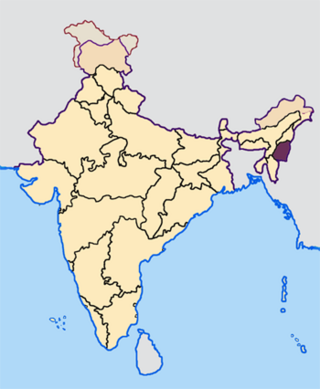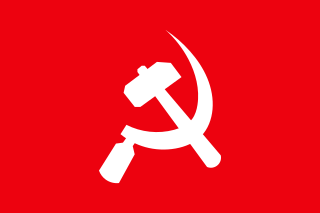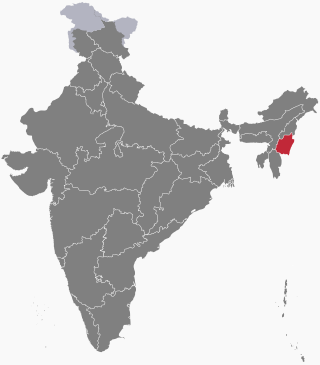Related Research Articles

Manipur is a state in northeast India, with the city of Imphal as its capital. It is bounded by the Indian states of Nagaland to the north, Mizoram to the south and Assam to the west. It also borders two regions of Myanmar, Sagaing Region to the east and Chin State to the south. The state covers an area of 22,327 km2 (8,621 sq mi). The official and most widely spoken language is the Meitei language. Native to the Meitei people, it is also used as a lingua franca by smaller communities, who speak a variety of other Tibeto-Burman languages. Manipur has been at the crossroads of Asian economic and cultural exchange for more than 2,500 years. This exchange connects the Indian subcontinent and Central Asia to Southeast Asia, East Asia, Siberia, regions in the Arctic, Micronesia and Polynesia enabling migration of people, cultures and religions.
Indian literature refers to the literature produced on the Indian subcontinent until 1947 and in the Republic of India thereafter. The Eighth Schedule to the Constitution of India has 22 officially recognised languages. Sahitya Akademi, India's highest literary body, also has 24 recognised literary languages.

Meitei, also known as Manipuri, is a Tibeto-Burman language of northeast India. It is the official language and the lingua franca of Manipur and one of the official languages India. Meitei is the most widely-spoken Tibeto-Burman language of India and third the most used language of northeast India after Assamese and Bengali. There are 1.76 million Meitei native speakers in India according to the 2011 census. Most of these, or 1.52 million, are found in the state of Manipur, where they represent majority of its population. There are smaller communities in neighbouring Indian states, such as Assam (168,000), Tripura (24,000), Nagaland (9,500), and elsewhere in the country (37,500). The language is also spoken by smaller groups in neighbouring Myanmar and Bangladesh.

The Meitei people, Meetei people, or Manipuri people is an ethnic group native to Manipur. They form the largest and dominant ethnic group of Manipur in Northeast India. They speak the Meitei language, one of the 22 official languages of the Indian Republic and the sole official language of Government of Manipur. The Meiteis primarily settled in the valley areas in modern-day Manipur, though a sizeable population has settled in the other Indian states of Assam, Tripura, Nagaland, Meghalaya, and Mizoram. There is also a notable presence of Meitei people in the neighbouring countries of Myanmar and Bangladesh. The Meitei ethnic group represents about 53% of Manipur's population.

The Insurgency in Northeast India involves multiple separatist militant groups operating in some of India's northeastern states, which are connected to the rest of India by the Siliguri Corridor, a strip of land as narrow as 14.29 miles (23.00 km) wide.

The Kuki people are an ethnic group in the Northeastern Indian states of Manipur, Nagaland, Assam, Meghalaya, Tripura and Mizoram, as well as the neighbouring countries of Bangladesh and Myanmar. The Kukis form one of the largest hill tribe communities in Northeast India, along with the adjoining regions of Bangladesh and Myanmar. In Northeast India, they are present in all states except Arunachal Pradesh. The Chin people of Myanmar and the Mizo people of Mizoram are kindred tribes of the Kukis. Collectively, they are termed the Zo people.

Senapati, is one of the 16 districts of the Indian state of Manipur. The present Senapati district was formed in December 2016, after spawning off the Sadar Hills region in the south into a separate Kangpokpi district. The district headquarter is located in the municipality of Tahamzam.
The People's Revolutionary Party of Kangleipak (PREPAK) is an armed insurgent group in Manipur demanding a separate and independent homeland. PREPAK was formed under the leadership of R. K. Tulachandra in 1977.
Moreh is a border town located on the India–Myanmar border in Tengnoupal district of the Indian state of Manipur. As a rapidly developing international trade point with the integrated customs and international immigration checkpoint, Moreh plays an important role in India's Look East Policy, trade and commerce under ASEAN–India Free Trade Area, India-Myanmar relationship, India–Myanmar–Thailand road connectivity, and Trans-Asian Railway connectivity.
The history of Manipur is reflected by archaeological research, mythology and written history. Historically, Manipur was an independent sovereign kingdom ruled by Meitei dynasty but at different point of time it was invaded and rule over by other state and authority. The Kangleipak State developed under King Loiyumba with its first written constitution in the early 12th century. Manipur under the 18th-century king Pamheiba saw the legendary burning of sacred scripture.

In the 2008 Imphal bombings, at least 17 people were killed and more than 30 were injured on 21 October 2008.
Tengnoupal is a hill town at the highest point of a road (NH-2) between Imphal and Moreh at the end of northwestern Myanmar; the ASEAN Highway passes through the village. It is the district headquarters of the recently reinstated Tengnoupal District and the administrative headquarters of yet to be formed Tengnoupal Autonomous District Council. The climate is cold all throughout the year and remains foggy during the rainy season. The village was founded by Pu Houlim Loikhom Mate and it is the largest village of the Kuki people in the district. The village due to its strategic location has seen many battles in the course of history including World War II.
Kanglei Yawol Kanna Lup is a Meitei separatist group in the state of Manipur in India formed in January 1994 by the unification of splinter groups like Ibopishak faction of the Kangleipak Communist Party (KCP) along with United National Liberation Front (UNLF) led by Namoijam Oken and the People's Revolutionary Party of Kangleipak (PREPAK) led by Meiraba. It was banned by the Government of India. The group displays a strong ethnonationalist and nativist rhetoric in their announcements.

Kangleipak Communist Party is a Maoist militant group in Manipur, India. Named after Kangleipak, the ancient name of Manipur, it was initially led by the communist ideologues — Ibohanbi and Ibopishak. The Kangleipak Communist Party (KCP) had been engaged in an armed conflict separatist insurgency in Manipur against the government of India.

The Insurgency in Manipur is an ongoing armed conflict between India and a number of separatist rebel groups, taking place in the state of Manipur. The Insurgency in Manipur is part of the wider Insurgency in Northeast India; it displays elements of a national liberation war as well as an ethnic conflict.

The following outline is provided as an overview of and topical guide to Manipur:

The Kuki National Army (KNA) is a Kuki insurgent group active in Northeast India and northwest Myanmar. It is the armed wing of the Kuki National Organisation.

Meitei nationalism refers to nationalism among the Meitei people. In the Meitei context this includes various movements throughout history to sustain Meitei cultural identity, political boundary, ethnicity and history to regain sovereign state status of Kangleipak.
On 3 May 2023, ethnic violence erupted in India's north-eastern state of Manipur between the Meitei people, a majority that lives in the Imphal Valley, and the Kuki-Zo tribal community from the surrounding hills. According to government figures, as of 15 September, 175 people have been killed in the violence. 1,108 others were injured while 32 are missing. 4,786 houses were burnt and 386 religious structures including temples and churches were vandalized. The violence left more than 70,000 people displaced from their homes. Unofficial figures are higher.

Arambai Tenggol is a Meitei activist organisation in the Indian state of Manipur, often described as a radical organisation, or as a radicalised armed militia. It is also a revivalist organisation that aims to reestablish the pre-Hindu, native Sanamahi religion among the Meiteis. It enjoys the patronage of Manipur's titular king and parliamentarian Leishemba Sanajaoba as well as the chief minister N. Biren Singh. During the 2023–2024 Manipur violence, members of the Kuki-Zo community blamed it for having carried out deadly attacks against them. In January 2024, the organisation demonstrated its influence by summoning all the elected Meitei legislators of the state for a meeting to deliberate on the defence of Meiteis in the prevailing conflict.
References
- ↑ "Archived copy" (PDF). Archived from the original (PDF) on 27 September 2011. Retrieved 19 January 2011.
{{cite web}}: CS1 maint: archived copy as title (link) - ↑ "About Tamil Sangam in Moreh State, Coming of Tamils to Morh, Manipur State". Archived from the original on 5 July 2011. Retrieved 19 January 2011.
- ↑ "Archived copy" (PDF). Archived from the original (PDF) on 17 June 2011. Retrieved 19 January 2011.
{{cite web}}: CS1 maint: archived copy as title (link) - ↑ "Fencing at border pillar 78 turning controversial — Indo-Burma News". Archived from the original on 22 July 2011. Retrieved 19 January 2011.
- ↑ "Eastern Mirror | The latest and breaking news from Nagaland, northeast India and India, current affairs in regional politics, latest updates on business news, sports and entertainment". www.easternmirrornagaland.com. Retrieved 16 May 2018.
- ↑ "Kendra Activities at Manipur". Archived from the original on 19 November 2010. Retrieved 19 January 2011.
- ↑ "About Tamil Sangam in Moreh State, Coming of Tamils to Morh, Manipur State". Archived from the original on 5 July 2011. Retrieved 19 January 2011.
- ↑ "Kendra Activities at Manipur". Archived from the original on 19 November 2010. Retrieved 19 January 2011.
- ↑ Pike, John. "People's Revolutionary Party of Kangleipak (PREPAK)" . Retrieved 15 May 2018.
- ↑ "No Amitabh, SRK films in Manipur – Times of India". The Times of India. Retrieved 15 May 2018.
- ↑ "Korea Comes to Manipur". Archived from the original on 27 April 2012. Retrieved 4 April 2012.
- ↑ "Manipur : 'Rioters tried to enter my house. When they couldn't, they burned it'". The Times of India. 10 August 2023. ISSN 0971-8257 . Retrieved 3 October 2023.
- ↑ Ghosh, Partha S. (24 September 2023). "Manipur's Tamil connection, via Myanmar: How ethnic polarisation has marooned the community again". Scroll.in. Retrieved 3 October 2023.
- ↑ Sabir, Aaisha (2 September 2023). "Tamils caught in the crossfire in strife-torn Manipur". The Hindu. ISSN 0971-751X . Retrieved 3 October 2023.
- ↑ "Manipur violence: Abandoned houses belonging to Meiteis torched at India-Myanmar border town". The New Indian Express. Retrieved 3 October 2023.